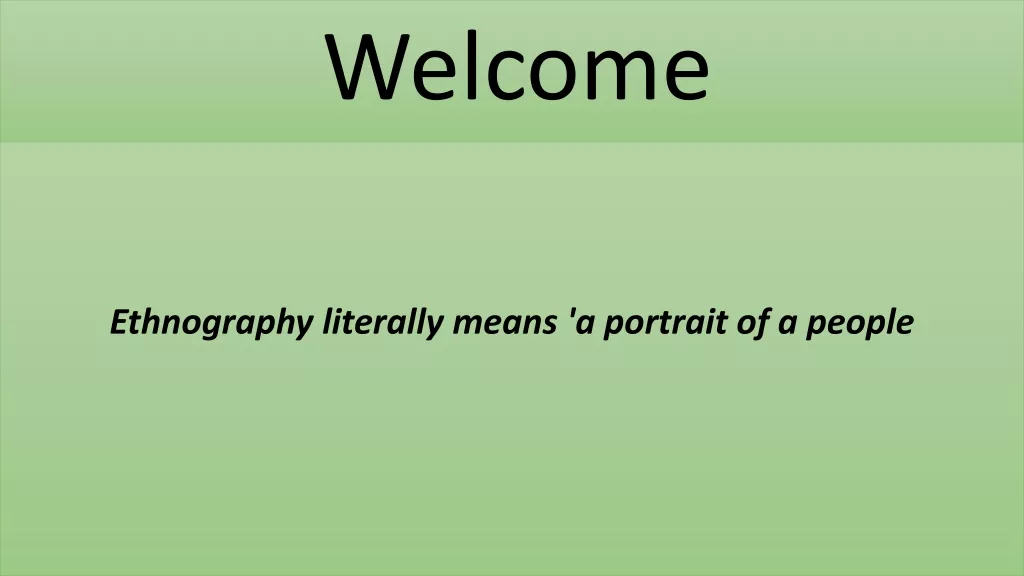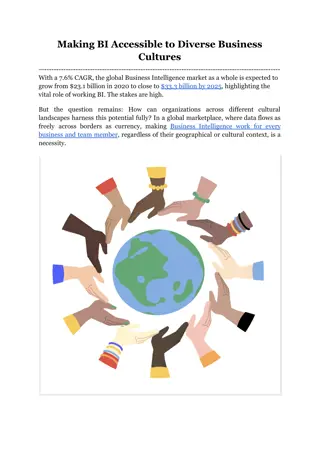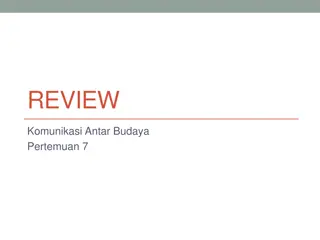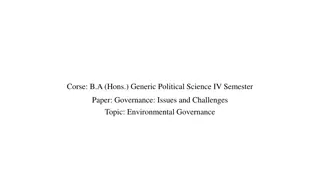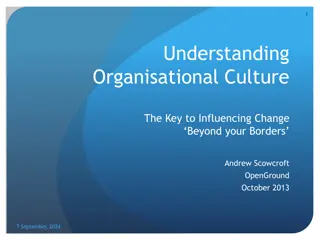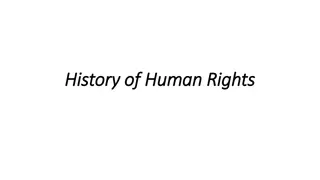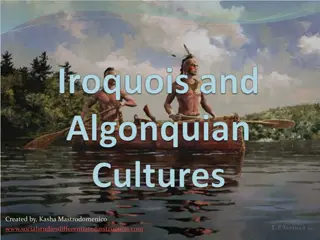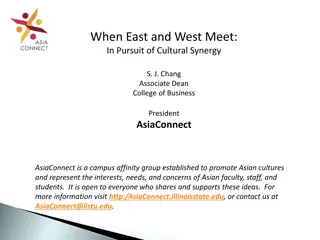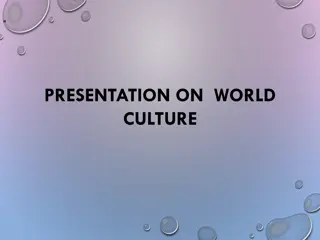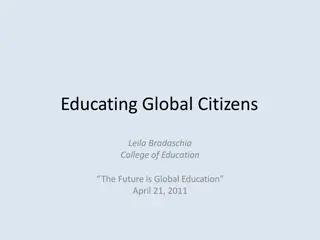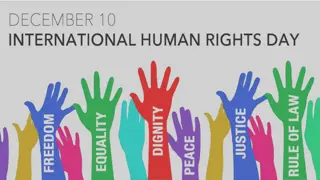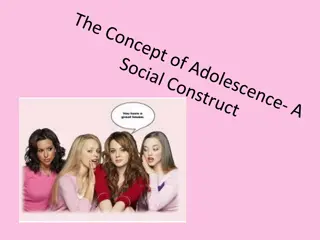Global Cultures: Human World Insights
Explore the fascinating realm of global cultures, from languages and religions to social structures and economic systems. Delve into the significance of communication, government, and the influence of beliefs on daily life. Discover the impact of cultural diffusion, information revolution, and globalization in shaping our interconnected world.
Download Presentation

Please find below an Image/Link to download the presentation.
The content on the website is provided AS IS for your information and personal use only. It may not be sold, licensed, or shared on other websites without obtaining consent from the author.If you encounter any issues during the download, it is possible that the publisher has removed the file from their server.
You are allowed to download the files provided on this website for personal or commercial use, subject to the condition that they are used lawfully. All files are the property of their respective owners.
The content on the website is provided AS IS for your information and personal use only. It may not be sold, licensed, or shared on other websites without obtaining consent from the author.
E N D
Presentation Transcript
Chapter 4 The Human World Global Cultures Population Geography Political Geography Economic Geography Urban Geography
Global Cultures Culture the way of life of a group of people who share similar beliefs and customs. Languages Key element in a culture s development. Communication Dialect local form of language that differs from the main language Pronunciation & Meaning of words Religion Government Language families large groups of related languages having similar roots & developed from one earlier language Organized by Linguists, scientists who study languages.
Global Cultures Religion - an organized collection of beliefs, cultural systems, and world views that relate humanity to an order of existence. Buddhism, Christianity, Hinduism, Islam, Judaism, & Sikhism Beliefs vary significantly around the world Enables a sense of identity Influences aspects of daily life Moral values, tradition, and holidays Symbols, history, art, architecture, music, etc. Social Groups develops to help the members of a culture work together to meet basic needs. Family is most important in most cultures Family structures vary Social Classes groups of people ranked according to ancestry, wealth, education, ethnicity, etc. Ethnic Groups - group of people who share common ancestry, language, religion, customs, or place of origin.
Global Cultures Government maintains order within the country, provides protection from outside dangers, and supplies services to its people. Organized according to levels of power and authority Power national, regional, & local Authority single ruler, small group of leaders, body of citizen or their representatives Economics the study how a culture utilizes its natural resources to meet such human needs as food and shelter. Culture region many different countries that have certain traits in common, including language, religion, economic systems, and values. Cultural diffusion the spread of cultural traits, material and non- material, from one culture to another. Culture hearth a center where cultures developed and from which ideas and traditions spread outward.
Global Cultures Information revolution the introduction of computers and the internet into world communication. Globalization the expansion of economic, political, and cultural ideas to the point where they become global in scale & impact. Connectivity the degree of connection or separation between people, places, and things. Standard of Living the level of wealth, goods, and necessities available for people to live. Outsourcing setting up businesses abroad to produce parts/products for domestic use or sale. Pandemic the spread of disease across a large area or even the world.
Population Geography 7 billion people live on Earth Inhabit 30% of Earth s land area 9 billion expected by 2050 Demography the study of populations. Birthrate number of births/year for every 1000 people. Death rate number of deaths/year for every 1000 people. Natural increase the growth rate of a population. Birthrate Death rate = Growth Rate Does not include migration Migration the movement of people from place to place. Immigrant a person who comes to live, permanently, in another country. Emigrant a person who leaves their home country to settle permanently in another country.
Population Geography Demographic transition the model that uses birthrate and death rates to show how population changes over time. Zero population growth birthrate & death rate are equal Doubling time number of years it takes a population to double in size. Varies depending on country. Community people with common interests living in a particular area. Population pyramid a diagram that show the distribution of a population by age and gender. Trend a general movement.
Population Geography Population distribution the variations in population that occur across an area. Affected by physical geography Asia 60% of the World s population Population density the average number of people living on a square mile of land. World Population = 7 billion 120/sq.mi. Macau (1) Population = 615K 55K/sq.mi. Greenland (244) Population = 56K 0.08/sq.mi. United States (182) Population = 320 million 85/sq.mi. China 1.4 Billion 369/sq.mi. Canada 36 million 9/sq.mi.
Political Geography Nearly 200 independent countries A government must make and enforce policies and laws that are binding upon all people living within its territory. Unitary System gives all key powers to the national or central government. United Kingdom, France Federal System divides the powers of the government between the national government and state or provincial governments. The United States Autocracy government in which one person rules with unlimited power and authority. Oldest and most common form of government Totalitarian dictator controls all aspects of government Germany Hitler, Iraq Hussein, Cuba Castro, N.Korea Jong Un Monarchy king or queen
Political Geography Monarchy a hereditary king or queen has supreme power. Absolute Monarch Saudi Arabia Constitutional Monarch United Kingdom, Japan, Jordan, Sweden Share governmental power Oligarchy a small group holds power. Wealth, military power, social status China Communist/Military Theocracy a divine power is head of the government. Religious leader Iran Ayatollah (Imam) Sharia Law Democracy the leaders rule with consent of the citizens. The United States
Political Geography Natural boundaries follows physical geographic features such as mountains or rivers. US/Mexico border Cultural boundaries geographically divide identifiable cultures, such as religion or language. Israel Geometric boundaries a boundary that follows a geometric pattern. US/Canada border, N.Korea/S.Korea border, United States
Economic Geography Three basic economic decisions What & how many goods should be produced. How they should be produced. Who gets the goods & services produced. Traditional economy tradition and custom control all economic activity. Old Indian cultures Market economy based on free enterprise. Businesses are privately owned. Prices determined by supply and demand. Shoppers determine what will me produced and sold based on free enterprise Free enterprise private individuals or groups have the right to own businesses and make profit with limited government interference. People have the choice of what to buy and where to work Capitalism factors of production are privately owned. Mixed economy the government supports and regulates free enterprise through decision that affect the marketplace. The United States Command economy government owns/directs the means of production and the distribution of goods. Communism & Socialism
Economic Geography Economic Development Primary economic activities Taking or using of natural resources directly from the land. farming, fishing, forestry, & mining Secondary economic activities use of raw materials to make products Manufacturing automobiles, pottery Tertiary economic activities provide services to people and businesses Doctors, teachers, lawyers, bankers, truck drivers Quaternary economic activities process, management, and distribution of information white collar , information technology Industrialization the development and spread of industry.
Economic Geography More developed countries highly developed economy and advanced technological infrastructure. United States, Japan, United Kingdom High literacy rates 95%+ Good health care High education level Long life expectancy Newly industrialized countries transitioning from primarily agricultural to primarily manufacturing and industrial activity. Mexico, China Literacy rates between 60-90% Varying education Varying health care Increasing life expectancy Less developed countries exhibits the lowest indicators of socioeconomic success. Agriculture remains dominant. Pakistan, Ethiopia, Haiti Low literacy rate - < 60% Few years of education Low expenditures on health care Low life expectancy
Urban Geography Urban sprawl spreading of urban developments on land near a city. More than 50% of the world s people live in cities. 82% of Americans live in a urban area. Connectivity the directness of routes & communication linking places. Metropolitan area a region that includes a central city and its surrounding suburbs. Urban a city or town. Rural the countryside, located outside of a city or town. Suburban residential area outside of a town or city. Urban land use models the way land is used in urban area Concentric Zone Model a city grows outward, from a central point, in a series of rings Sector Model a city develops in sectors instead of rings. Multiple Nuclei Model city contains more than one center around which activities revolve.
Urban Geography Central place theory a spatial theory that attempts to explain the reasons behind the distribution patterns, size, and number of cities and towns around the world. World city cities generally considered to play an important role in the global economic system. International, diverse culture Active influence on world affairs Large population International airport Advanced transportation system New York, Washington D. C. , Paris, Tokyo Urbanization - population shift from rural to urban areas, "the gradual increase in the proportion of people living in urban areas", and the ways in which each society adapts to the change.




